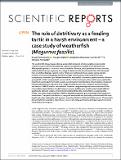The role of detritivory as a feeding tactic in a harsh environment – a case study of weatherfish (Misgurnus fossilis)
Date
11/06/2019Metadata
Show full item recordAbstract
The weatherfish (Misgurnus fossilis) is a species that is tolerant of unfavourable environmental conditions and can survive low dissolved oxygen concentrations and high water temperatures. Although this species occurs across almost the whole of Europe, and is protected in many countries, relatively little is known regarding its ecology. To determine the diet of weatherfish, 120 individuals from an artificial drainage canal in central Poland were collected in two seasons (spring and late summer) with contrasting abiotic condition (oxygen concentration, water temperature and transparency). Analysis of gut fullness showed that weatherfish consumed a greater quantity of food in spring (0.92 ± 0.90) compared with summer (0.20 ± 0.26). Contrary to other cobitid taxa, weatherfish fed actively during daytime in both seasons. An estimate of the importance of each dietary component indicated that the most important food categories were chironomids, copepods, Asellus aquaticus and detritus. SIMPER analysis indicated that these four categories together constituted over 65.8% of cumulative dissimilarity in the diet between seasons. Additionally, trophic niche breadth differed significantly between seasons. The study demonstrated that the weatherfish is an opportunistic feeder, consuming large quantities of detritus despite possessing a gut morphology that is atypical of a detritivore. The quantity of detritus in the gut of weatherfish was positively associated with fish total length and varied seasonally, with a greater quantity of detritus in the diet in late summer. These results demonstrate the importance of detritus as a source of energy, particularly during periods of scarcity of alternative prey categories.
Citation
Pyrzanowski , K , Zięba , G , Dukowska , M , Smith , C & Przybylski , M 2019 , ' The role of detritivory as a feeding tactic in a harsh environment – a case study of weatherfish ( Misgurnus fossilis ) ' , Scientific Reports , vol. 9 , 8467 . https://doi.org/10.1038/s41598-019-44911-y
Publication
Scientific Reports
Status
Peer reviewed
ISSN
2045-2322Type
Journal article
Description
This study was supported by the University of Łódź, Grant No. B1711000001529.02 (grants for young scientists).Collections
Items in the St Andrews Research Repository are protected by copyright, with all rights reserved, unless otherwise indicated.

